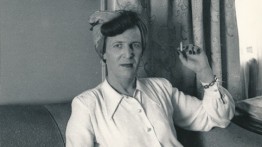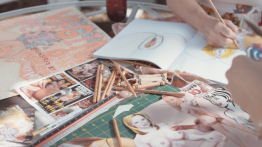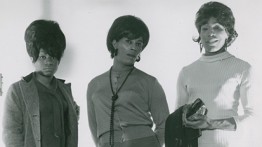Gender Myths Exploded
POSTED ON: October 12, 2015
A new exhibition entitled Bring Your Own Body: transgender between archives and aesthetics will open in the 41 Cooper Gallery on October 13. The show presents the work of contemporary transgender artists who in various ways confront and engage the past, whether mining the archives of well known sexologists like Alfred Kinsey or celebrating the pioneering work of early transgender activists. The exhibition draws on the archives of the Kinsey Institute and the Transgender Archives of the University of Victoria in British Columbia. The show brings together a wide range of photographs, paintings, sculpture, textiles, film, digital collage and performance.
“There isn’t a single trans narrative, and we wanted the exhibition’s media to convey that,” says Stamatina Gregory, associate dean of the School of Art, who co-curated the exhibition with Jeanne Vaccaro, a curator and post-doctoral fellow at Indiana University where the archives at the Kinsey Institute are housed. Gregory thinks the show is arriving at the right time in the right place: “We have such a strong trans community of students, students that are really working hard to see the programming that they’d like to see here. They’re changing the environment of their pedagogy on their own, and I thought what a wonderful opportunity to work with some of our students who are thinking the most about what their education is giving them.”
The exhibition, which runs until November 14, draws on materials from a number of archives of renowned sexologists including Alfred Kinsey, John Money and Harry Benjamin. Vaccaro, who is also a research fellow at the Kinsey Institute, found that the archives, while sometimes disturbing in their pathologizing of transgender people, held some examples of extraordinary resilience and bravery. Louise Lawrence, for instance, was a transgender woman who started a correspondence with Kinsey.
“She was really on a mission to get him to think about gender in a more expansive way,” said Vaccaro. To that end, Lawrence sent Kinsey scrapbooks filled with articles about same sex couples living as man and woman; men arrested for female impersonation, which became a crime in cities around the country in the late 19th century.
Chris Vargas, an artist based in the Pacific Northwest whose work will be featured in the exhibition, visited Kinsey with Vaccaro, not sure what to expect from the archives. “I assumed the documents in the archive related to transsexualism would be more cold and clinical in nature,” he said. “But I was struck by the friendliness and warmth that I saw in the many letters between Louise Lawrence and Dr. Alfred Kinsey.” He also noticed that Dr. Money drew what Vargas calls “psychedelic doodles” with colored markers and pens along the margins and backs of symposia notes. The drawings, Vargas notes, “revealed that not only was he a complicated individual but he fancied himself an artist, as well. There was one instance where he included exhibition instructions for some hand-drawn slides he created.”
Vargas, who is the founder of the Museum of Transgender Hirstory & Art, has designed a collage entitled “Transvestites in the News,” the name Lawrence gave to her scrapbooks. The collage will be printed as a broadsheet that will be available for visitors to the exhibition. Vargas chose the medium because it recalls the black-and-white newspaper articles that appear in Lawrence’s albums, which were about documenting 1950s views of gender. “I was drawn to Lawrence’s scrapbook because of its relevance to the current fascination that mass media and television is having with anything ‘transgender.’ Trans stories are being packaged as new and exciting, and I feel distrustful, because I know that’s not true.”
The extensive archives at the Kinsey Institute certainly prove Vargas’s point. With more than a dozen collections of sex researchers such as Magnus Hirschfeld (1868-1935) – viewed as the founder of the German gay rights movement – and the papers of the famed team Masters and Johnson, the Institute offers a highly complicated picture of the reception of transgender people throughout the 20th century. As Vargas discovered, there were instances of friendship, curiosity and determination. Yet there were also many acts of violence documented among the Institute’s thousands of photographs, clippings and reports. As Vaccaro points out, some of the material comes from police records, including mug shots for sex work or female impersonation.
As dependent as the exhibition is on archival materials, the curators have been particularly conscious about the ways that subjects have been represented, keeping in mind the circumstances under which their identities were captured, in many cases without consent. “The only way we can show this kind of work is in the context of intervention,” Gregory said.
A number of events have been scheduled during the run of the exhibition. On Thursday, October 22, niv Acosta will be continuing his DISCOTROPIC series with “Alien Talk Show.” In collaboration with other performers, Acosta tapes a talk show that in the words of the curators, is designed to “revisit past futures and claim a fantastical site of possibility.” A dancer and multi-media artist, Acosta says that the series has been inspired by his fascination with disco: after its heyday in white and mainstream culture, Acosta says, some black artists kept pushing the boundaries of the form. “The people who remained in the realm of disco and were black got weirder and weirder, and that’s what I’m interested in.” He cites disparate influences --Sun Ra, the Afrofuturist jazz pianist is one; Carl Sagan’s another. It’s no surprise then that Acosta likes to combine genres, most notably science fiction and astrophysics. (He once had been on track to become an astrophysicist.) They are discourses, he says, that are “based on speculation, a mode of inquiry very familiar to the black American experience. These genres are based on creating a space based on nothing or very little. That’s an experience I’m very familiar with and the people I work with are too.”
Flawless Sabrina, a pioneering transgender artist and activist, surely understands that sentiment. In 1958, she started “The Nationals,” traveling weekly pageants. Drag queens competed for the title Miss All-America Camp Beauty in locations around the country. On October 24, the curators will screen the 1968 film The Queen about a New York edition of the pageant held in The Town Hall. Sabrina herself will be on hand to talk about her work as an artist, journalist and film producer. Highly influential in the transgender movement, she has worked with artists from Andy Warhol to David Bowie and been the subject of images by Diane Arbus, Francesco Scavullo and most recently Zackary Drucker. After the film, Drucker and archivist Diane Tourjee will join Sabrina to talk about their project cataloging the Flawless Sabrina Archive, which contains film, sculpture, writing, photography, painting and music. In addition to original work by Sabrina herself, the collection contains pieces by her contemporaries including William S. Burroughs, Sabrina’s lover of many years.
Drucker, whose visual and performance art examines how we think about gender and sexuality, looks to Sabrina as a grandmother figure for herself and the trans movement at large. Gregory says that in many ways the exhibition is about legacy—the legacy of older activists and artists, as well as the legacy of the archives themselves. “You don’t choose your ancestors; there are forgotten histories in these archives—it’s huge and it’s ongoing. “







